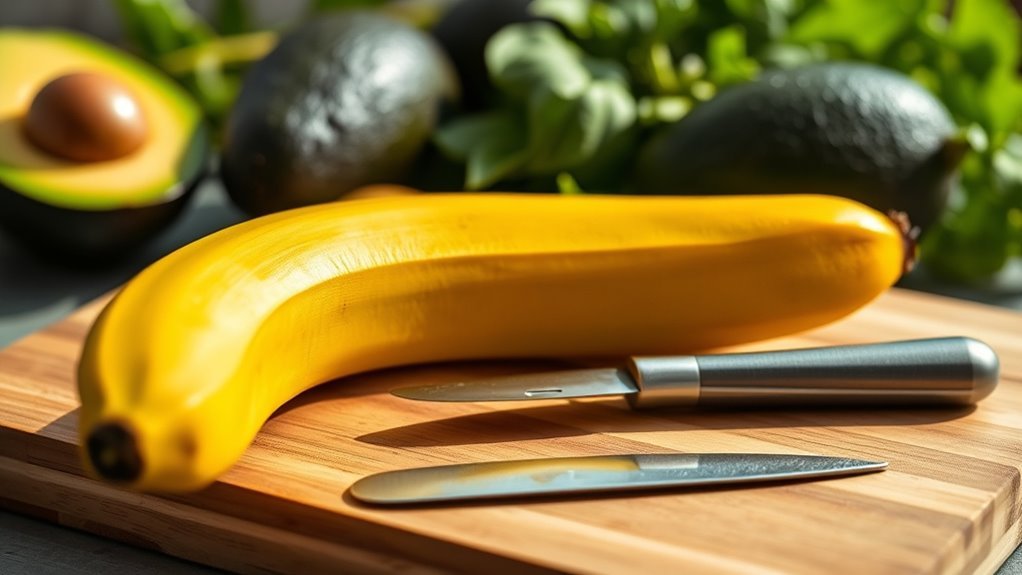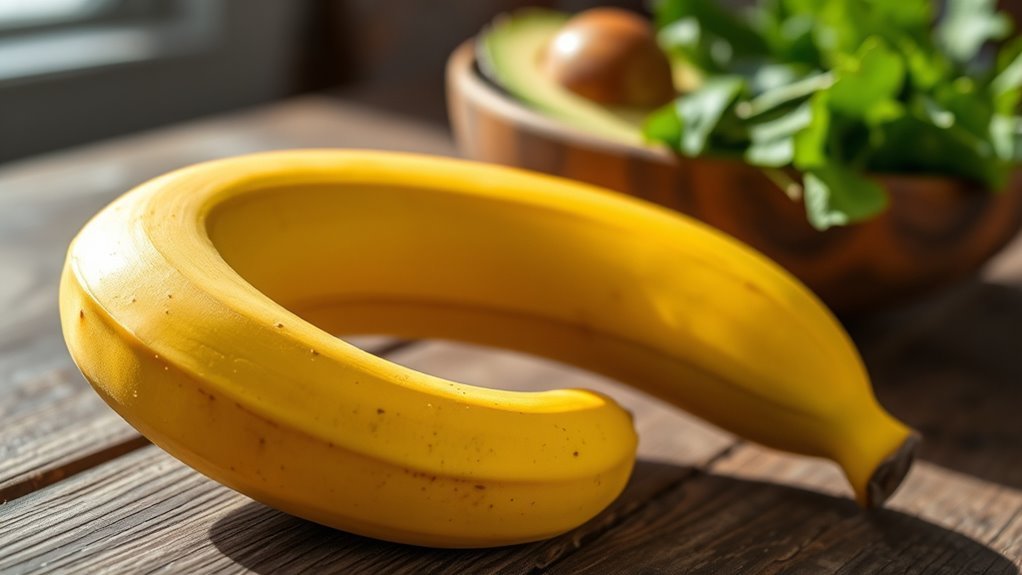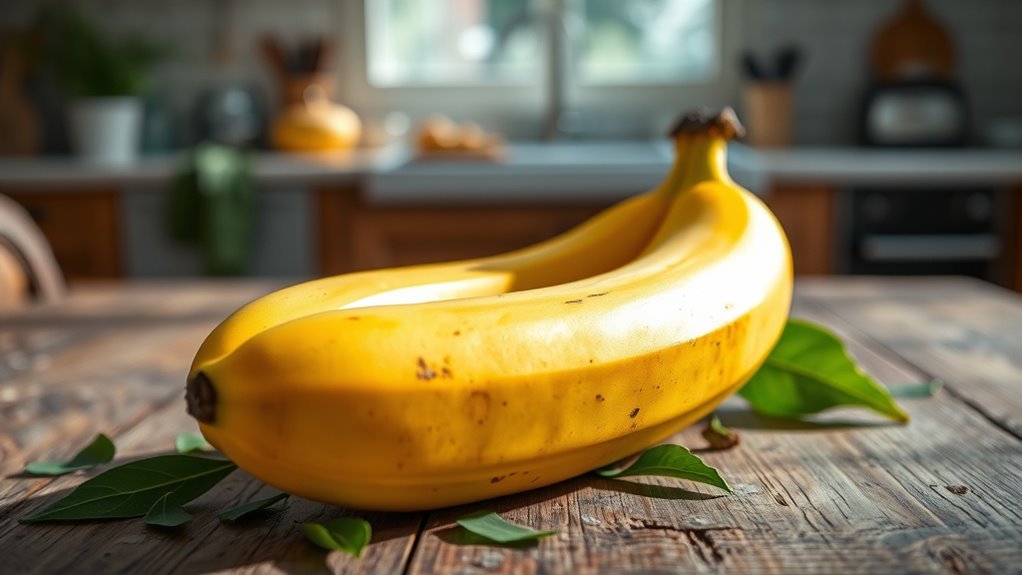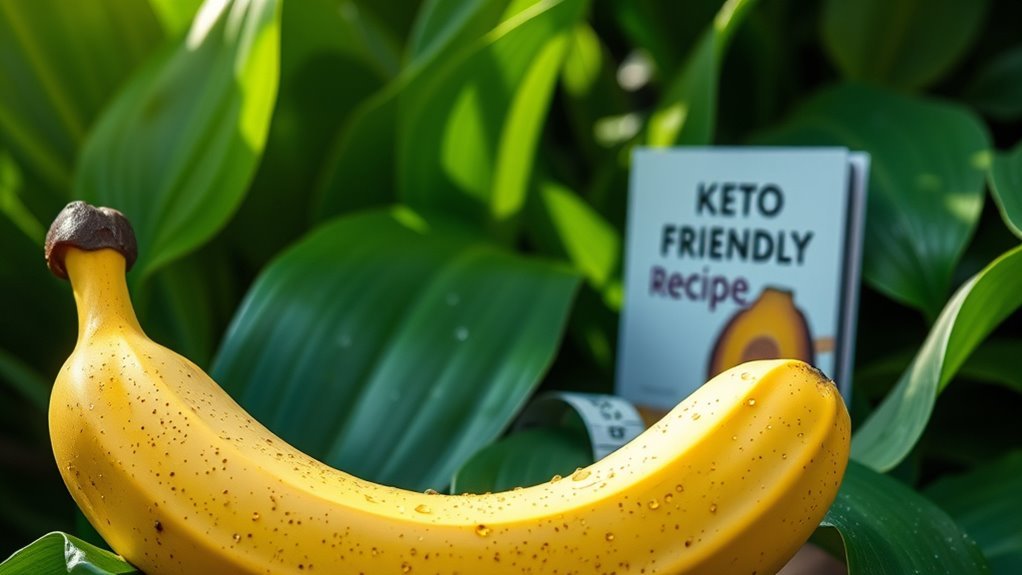You can’t realistically eat bananas on a ketogenic diet due to their high carbohydrate content, which can exceed your daily limit and disrupt ketosis. A medium banana has about 27 grams of carbs, far surpassing the recommended 20-50 grams for the entire day. Instead, consider low-carb fruit alternatives like berries or avocados that can satisfy your cravings without derailing your diet. If you’d like to explore more about managing fruit intake on keto, options are available.
Understanding the Ketogenic Diet

When you’re exploring the ketogenic diet, it’s important to understand its fundamental principles. At its core, the ketogenic diet is about drastically reducing carbohydrate intake while increasing healthy fats. The typical macronutrient ratios aim for about 70-75% fats, 20-25% protein, and only 5-10% carbohydrates. This shift encourages your body to enter ketosis, a state where it burns fat for fuel instead of glucose. Understanding these ketogenic principles can empower you in making informed food choices that align with your goals. You might find this approach liberating, as it allows you to explore a variety of foods, provided they fit within those specific macronutrient ratios. Ultimately, it’s about finding a balance that works for your lifestyle and health aspirations.
Nutritional Profile of Bananas

When considering bananas on a keto diet, it’s important to look at their nutritional profile, particularly their carbohydrate content. A medium banana contains about 27 grams of carbohydrates, which can greatly impact your daily intake on keto. Additionally, bananas are rich in vitamins and minerals, including potassium and vitamin C, adding nutritional value despite their higher carb count.
Carbohydrate Content Overview
Though bananas are often celebrated for their health benefits, their carbohydrate content can pose a challenge for those following a ketogenic diet. On average, a medium ripe banana contains about 27 grams of carbohydrates, which primarily come from natural sugars and starches. When you consider the daily carb limit on keto is typically around 20-50 grams, that single banana can take up a significant portion of your allowance. Different banana varieties, such as plantains or baby bananas, may have varying carbohydrate levels, but they generally remain high in carbs compared to other low-carb fruit options. If you’re seeking alternative carbohydrate sources on keto, you might want to explore berries or avocados, which provide lower carb counts while still offering nutritional benefits.
Vitamins and Minerals Present
Bananas are not just high in carbohydrates; they also pack a variety of essential vitamins and minerals that contribute to overall health. One of the key banana benefits is its status as a potassium source, which plays a crucial role in maintaining heart health and regulating blood pressure. Additionally, bananas are rich in vitamin content, particularly vitamin C and B6, which support immune function and energy metabolism. Their nutrient density makes them a convenient option for those seeking a quick energy boost. While they may not fit perfectly into a strict keto diet, understanding their nutritional profile helps you make informed decisions about incorporating bananas into your lifestyle, especially if you value overall well-being.
Carbohydrate Limits on Keto

On a keto diet, your daily carbohydrate allowance typically ranges from 20 to 50 grams to maintain ketosis. Understanding which foods fit this limit is essential, as even small amounts of sugar can impact your state of ketosis. By focusing on keto-friendly foods, you can enjoy a variety of options while staying within your carbohydrate goals.
Daily Carb Allowance
While adhering to a ketogenic diet, understanding your daily carb allowance is essential for maintaining ketosis and achieving your health goals. Typically, you’ll want to limit your net carbs to around 20-50 grams per day. This makes daily carb tracking vital for effective keto meal planning. Here’s a simple breakdown to help you visualize:
| Meal Type | Suggested Carb Limit | Example Foods |
|---|---|---|
| Breakfast | 5-10 grams | Eggs, avocado |
| Lunch | 5-15 grams | Salad, grilled meat |
| Dinner | 5-15 grams | Fish, low-carb veggies |
| Snacks | 5-10 grams | Nuts, cheese |
Keto-Friendly Foods
When following a ketogenic diet, it’s important to choose foods that align with your carbohydrate limits to maintain ketosis effectively. Focus on low-carb, high-fat options like avocados, nuts, and leafy greens. These foods not only support your keto goals but also provide essential nutrients. For quick keto snack ideas, consider cheese sticks, olives, or celery with cream cheese. Planning is key, so engage in keto meal prep by preparing dishes in advance, ensuring you always have compliant meals ready to go. You can whip up cauliflower rice or zucchini noodles to replace higher-carb options. Embracing these choices gives you the freedom to enjoy delicious meals without derailing your progress on the ketogenic journey.
Impact of Sugar
Understanding the impact of sugar on a ketogenic diet is essential for maintaining your carbohydrate limits and staying in ketosis. Different sugar types, like glucose and fructose, can spike insulin levels, disrupting your state of ketosis. On keto, you’ll want to limit your intake of these sugars, found in many fruits, including bananas. Instead, consider sugar alternatives such as erythritol or stevia, which have little to no effect on blood sugar. These options allow you to satisfy your sweet tooth without derailing your diet. By being mindful of sugar types and choosing suitable alternatives, you can enjoy a keto lifestyle while still embracing the freedom of flavor in your meals. Your journey to health can be both satisfying and rewarding!
The Impact of Bananas on Ketosis
Although bananas are often praised for their nutritional benefits, incorporating them into a ketogenic diet can be challenging due to their high carbohydrate content. Eating a banana can greatly affect your ketosis impact, making it harder to maintain the metabolic state necessary for burning fat. If you’re seeking freedom in your diet while staying keto, you might want to explore banana alternatives like berries, avocados, or nuts, which are lower in carbs and can satisfy your cravings without disrupting ketosis. These substitutes not only offer similar flavors and textures but also provide essential nutrients, allowing you to enjoy your meals without compromising your dietary goals. Staying informed about your food choices helps you navigate the keto lifestyle effectively.
How Many Carbs Are in a Banana?
When considering bananas on a keto diet, it’s essential to understand their carbohydrate content. A medium banana typically contains about 27 grams of carbs, which can considerably impact your daily intake depending on your goals. Additionally, factors like serving size and the fruit’s glycemic index can influence how it affects your body’s insulin response.
Carbohydrate Content Overview
Bananas are often considered a convenient and nutritious snack, but their carbohydrate content can pose a challenge for those following a ketogenic diet. A medium banana contains about 27 grams of carbs, which can quickly use up your daily allowance on keto. Here’s a quick overview of carbohydrate content in bananas:
- Medium Banana: ~27 grams of carbs
- Small Banana: ~23 grams of carbs
- Large Banana: ~31 grams of carbs
- Extra-Large Banana: ~35 grams of carbs
With these numbers in mind, you might want to explore banana alternatives. Opting for lower-carb keto snacks like berries, nuts, or seeds can keep you within your limits while satisfying your cravings.
Glycemic Index Impact
While many people enjoy bananas for their taste and convenience, it’s important to contemplate their glycemic index (GI) when following a ketogenic diet. Bananas have a higher GI, which means they can trigger a significant glycemic response, leading to increased insulin levels. This can be counterproductive for those aiming to maintain ketosis.
| Banana Ripeness | Glycemic Index (GI) |
|---|---|
| Unripe | 30 |
| Ripe | 51 |
| Overripe | 70 |
Understanding the impact of bananas on your blood sugar is essential. If you’re keen on keeping your carb intake low, consider alternatives with a lower GI that won’t disrupt your ketosis goals. Enjoy your freedom of choice, but stay informed!
Serving Size Considerations
Understanding serving sizes is essential when considering how many carbs are in a banana, especially on a ketogenic diet. Bananas can be higher in carbs than you might realize, so practicing portion control is vital. Here’s a breakdown to help you manage your intake:
- Small Banana (6-7 inches): Approximately 23 grams of carbs.
- Medium Banana (7-8 inches): About 27 grams of carbs.
- Large Banana (8-9 inches): Roughly 31 grams of carbs.
- Extra-Large Banana (over 9 inches): Can have around 35 grams of carbs.
Alternatives to Bananas on Keto
If you’re following a keto diet and craving the sweetness of fruit, there are several alternatives to bananas that can satisfy your taste buds without derailing your carb count. Consider options like berries, which are low in carbs and high in antioxidants, making them perfect keto snacks. Raspberries and strawberries can be great fruit substitutes, offering both flavor and nutrition. You might also enjoy melon varieties like cantaloupe or honeydew in moderation, as they provide hydration and a touch of sweetness. Avocados, while not sweet, can be a creamy, satisfying option that fits your keto lifestyle. Don’t forget about coconut, either—it’s versatile and adds a tropical flair without the carbs that bananas bring. Enjoy experimenting with these substitutes!
Low-Carb Fruits You Can Enjoy
Although many fruits are high in carbohydrates, there are still plenty of low-carb options you can enjoy on a keto diet. Incorporating these fruits into your meals can satisfy your sweet tooth while keeping you on track. Here are some great choices:
Many fruits are high in carbs, but there are delicious low-carb options perfect for your keto diet.
- Raspberries – Bursting with flavor and only 5 grams of net carbs per cup.
- Strawberries – A delicious addition to your keto friendly snacks, with about 6 grams of net carbs per cup.
- Blackberries – Rich in nutrients, containing just 6 grams of net carbs per cup.
- Avocado – While technically a fruit, it’s low in carbs and high in healthy fats.
These low carb berries can help you maintain ketosis without sacrificing taste! Enjoy them guilt-free!
Incorporating Fruits Into a Keto Meal Plan
When you’re planning your keto meal plan, incorporating fruits can be a delicious way to add variety and essential nutrients without derailing your carb count. Focus on low-carb fruit selection, such as berries, avocados, and tomatoes, which can provide vitamins and minerals while keeping your net carbs in check. When you’re meal planning, think about using fruits as toppings for salads or blending them into smoothies for added flavor. Remember to monitor portion sizes, as even low-carb fruits can contribute to your overall carb intake. Balancing your meals with the right fruits allows you to enjoy their benefits while staying in ketosis, giving you the freedom to savor delicious foods without feeling restricted.
Tips for Managing Cravings on Keto
Managing cravings on keto can be challenging, especially during the initial stages of the diet. To help you navigate those tough moments, consider these craving management strategies:
- Stay Hydrated: Sometimes, thirst can be mistaken for hunger. Drink plenty of water throughout the day.
- Opt for Healthy Snacks: Keep keto-friendly snacks like nuts, cheese, or celery on hand to curb sudden cravings.
- Plan Your Meals: Having structured meals can help you avoid impulsive eating and reduce temptation.
- Mindful Eating: Focus on your meals without distractions. This can enhance satisfaction and reduce the urge to snack unnecessarily.
Balancing Nutrients While on Keto
Cravings on keto often stem from nutrient imbalances, making it important to focus on balanced nutrition as you navigate this low-carb lifestyle. To maintain energy levels and curb those cravings, you should prioritize nutrient timing and meal planning. Aim to include a variety of healthy fats, adequate protein, and low-carb vegetables in your meals. This approach guarantees you’re getting essential vitamins and minerals, which can help stabilize your mood and appetite. By planning your meals ahead of time, you can avoid impulsive food choices that might derail your progress. Remember, a well-rounded keto diet isn’t just about restricting carbs; it’s about nourishing your body and enjoying the freedom to feel good while still adhering to your dietary goals.


